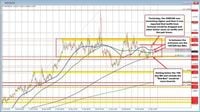As markets hold their breath for a pivotal announcement from President Donald Trump regarding tariffs on Canadian imports, the USD/CAD currency pair is experiencing notable fluctuations. The announcement is set for 4:00 PM EDT today, April 2, 2025, and traders are keeping a close eye on economic indicators that could influence the outcome.
In recent days, the Canadian dollar has gained traction, buoyed by weaker-than-expected U.S. economic data that has raised concerns about a potential recession. Reports from the Institute for Supply Management (ISM) revealed a decline in manufacturing activity, with the Purchasing Managers Index (PMI) dropping from 50.3 to 49.0, signaling contraction. This has led to speculation that the Federal Reserve may need to cut interest rates to stimulate growth.
Meanwhile, the U.S. dollar has retreated modestly. It opened at 1.4312 against the Canadian dollar, with an overnight trading range of 1.4284 to 1.4327, and closed at 1.4304. The price of West Texas Intermediate (WTI) crude oil sits at $71.15, while gold is priced at $3,130.99. The fluctuations in these commodities are crucial, as Canada is a significant oil exporter to the U.S., and higher oil prices typically support the Canadian dollar.
Asian equity markets reflected a cautious sentiment, with Japan’s Topix index slipping by 0.53%, while Hong Kong’s Hang Seng closed unchanged, and Australia’s ASX 200 managed a modest gain of 0.12%. In Europe, markets faced pressure, with the German DAX down 1.0% and the UK FTSE 100 off by 0.62%. S&P 500 futures also indicated a downward trend, declining by 0.57%.
The looming tariff announcement has ignited discussions among U.S. lawmakers. Some senators are actively seeking to block Trump’s proposed blanket tariff of 25% on Canadian imports. This political maneuvering adds another layer of uncertainty to the economic landscape, as a successful blockade could alleviate some of the pressures facing the Canadian economy and allow the Bank of Canada to continue its easing cycle.
Market participants are particularly concerned about the implications of Trump’s tariffs not just for Canada, but for the broader global economy. The tariffs could escalate trade tensions and reignite inflationary pressures, especially in the U.S. The expectation of reciprocal tariffs has also fueled fears that other trading partners may retaliate, further complicating the situation.
In the lead-up to the announcement, the USD/CAD pair has shown mixed signals. The pair recently tested resistance levels around 1.4400 but has struggled to maintain momentum above this threshold. Analysts note that the recent price action has been characterized by both lower-highs and higher-lows, indicating a consolidation phase. A break above 1.4400 could signal a renewed bullish trend, while failure to do so might reinforce bearish sentiments.
As traders await the tariff developments, the focus remains on the technical analysis of the USD/CAD pair. Currently, the pair is testing support in the 1.4280-1.4300 range, with resistance levels identified at 1.4371 and 1.4402. Should the price fall below the 100-day moving average at 1.4278, it could strengthen bearish momentum, leading to deeper losses.
Looking at the broader economic picture, the U.S. private sector added 155,000 jobs in March, surpassing expectations of 105,000. However, this positive news has not been enough to counterbalance the concerns surrounding the manufacturing sector's performance. The job growth reflects a resilient labor market, but the potential impact of tariffs on consumer prices and overall economic activity remains a significant worry.
In Canada, Statistics Canada is expected to report an increase of 12,000 jobs for March, up from just 1,100 in February. This positive employment data could provide a much-needed boost to the Canadian dollar, especially if it coincides with a favorable outcome from the tariff discussions.
As the clock ticks down to Trump’s announcement, market sentiment is cautious yet hopeful. The potential for tariff relief has sparked optimism among traders, but the uncertainty surrounding the specifics of the tariffs and their implementation continues to weigh heavily on the markets. The next few hours will be critical in determining the direction of the USD/CAD pair and the broader economic outlook for both the U.S. and Canada.
In summary, the USD/CAD currency pair is navigating a complex landscape influenced by economic data, political maneuvering, and impending tariff announcements. As traders brace for potential volatility, the outcome of today’s events could have lasting implications for both currencies and the economic relationship between the U.S. and Canada.








